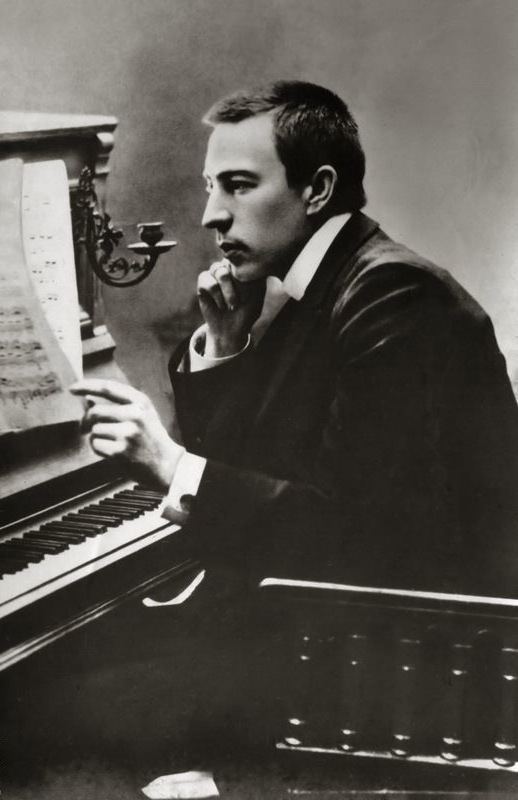 | ||
The Piano Concerto No. 2 in C minor, Op. 18, is a concerto for piano and orchestra composed by Sergei Rachmaninoff between the autumn of 1900 and April 1901. The second and third movements were first performed with the composer as soloist on 2 December 1900. The complete work was premiered, again with the composer as soloist, on 9 November 1901, with his cousin Alexander Siloti conducting.
Contents
- Background
- Composition
- Moderato C minor
- Adagio sostenuto Pi animato Tempo I C minor E major
- Allegro scherzando E major C minor C major
- Derivative works
- Popular culture
- References
This piece is one of Rachmaninoff's most enduringly popular pieces, and established his fame as a concerto composer.
Background
At its 1897 premiere, Rachmaninoff's first symphony, though now considered a significant achievement, was derided by contemporary critics. Compounded by problems in his personal life, Rachmaninoff fell into a depression that lasted for several years. His second piano concerto confirmed his recovery from clinical depression and writer's block, cured only by a course of hypnotherapy. The concerto was dedicated to Nikolai Dahl, a physician who had done much to restore Rachmaninoff's self-confidence.
Composition
The work is scored for 2 flutes, 2 oboes, 2 clarinets in B♭ (I mov.) and A (II & III mov.), 2 bassoons, 4 horns in F, 2 trumpets in B♭, 3 trombones (2 tenor, 1 bass), tuba, timpani, bass drum, cymbals, solo piano, and strings. It is written in three-movement concerto form.
Moderato: C minor
The opening movement begins with a series of bell-like tollings on the piano that build tension, eventually climaxing in the introduction of the main theme. In this first section, the orchestra carries the Russian-character melody while the piano makes an accompaniment made of rapid oscillating arpeggios. After the statement of the long first theme, a quicker transition follows until the lyrical second theme, in E flat major, is presented. The exposition ends with an agitated closing section.
The agitated and unstable development borrows motives from both themes changing keys very often and giving the melody to different instruments while a new musical idea is slowly formed. The music builds in a gradual climax as if the first bars were to be repeated, but in the recapitulation the theme is presented as unique to the first statement.
While the orchestra restates the first theme, the piano, that in the other occasion had an accompaniment role, now plays the march-like theme that had been halfly presented in the development, thus making a considerable readjustment in the exposition, as the main theme, played by the orchestra has become an accompaniment. This is followed by a piano solo, which leads into a descending chromatic passage. Then the second theme is heard, beginning with a horn solo. It starts with an unexpected key of A-flat major but in a short while it moves back to C minor. From the beginning of this theme the movement is placid until drawn into the agitated closing section, and the movement ends in C minor fortissimo.
Adagio sostenuto – Più animato – Tempo I: C minor → E major
The second movement opens with a series of slow chords in the strings which modulate from the C minor of the previous movement to the E major of this movement.
At the beginning of the A section, the piano enters, playing a simple arpeggiated figure. This opening piano figure was composed in 1891 as the opening of the Romance from Two Pieces For Six Hands. The main theme is initially introduced by the flute, before being developed by an extensive clarinet solo. The motif is passed between the piano and then the strings.
Then the B section is heard. It builds up to a short climax centred on the piano.
The original theme is repeated, and the music appears to die away, finishing with just the soloist in E major.
Allegro scherzando: E major → C minor → C major
The last movement opens with a short orchestral introduction that modulates from E (the key of the previous movement) to C minor, before a piano solo leads to the statement of the agitated first theme. After the original fast tempo and musical drama ends, a lyrical theme is introduced by the oboe and violas. This second theme maintains the motif of the first movement's second theme.
After that a mysterious, suspenseful, and scary development section is heard, which leads to the recapitulation.
In the recapitulation, an extended variation of the first theme is heard, and then there is an extended variation of the 2nd theme. The recapitulation's 2nd theme begins lyrically like how it was in the exposition. However, it then builds up into a triumphant climax in C major. The movement ends very triumphantly in this key.
Derivative works
The second theme of Allegro scherzando provides the basis for Frank Sinatra's 1945 "Full Moon and Empty Arms".
The Adagio sostenuto theme appears in Eric Carmen's 1975 ballad "All by Myself". Carmen first composed the song's interlude, then took the bridge from Rachmaninoff and the chorus from his own "Let's Pretend". Carmen explained that Rachmaninoff was his "favorite music".
The Moderato theme appears in Muse's 2001 song "Space Dementia". The lyric line "And tear us apart and make us meaningless again" follows exactly Rachmaninoff's melody in the first movement, which is first played by string instruments in the beginning of the movement, and then again by the piano toward the movement's finale. The 1941 Sinatra song "I Think of You" is also based on the Rachmaninoff first movement.
